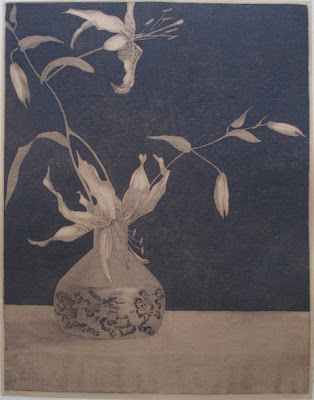Hendrik Christiaan Spruit
(H.C. Spruit)
(Cilacap-Java 1881 - 1942 the-Hague)
Dutch painter, teacher and grafic artist,
wayward linoleum-etcher.
For this weekend, after some serious hesitation and as an exception I've decided letting you into a secret with meeting one of my most special and favorite printmakers. But also one of the most forgotten, neglected and obscured artists. Concerning his biography there's nothing much to go on in the public archives but I've decided sharing what I've found and collected so far. Often reactions om postings lead to new material and facts. Let's hope so.
Born in Netherlands Dutch-Indies (Cilacap on the south coast of Java) in 1881 by Dutch parents he returned (in or around 1907) as did probably his parents, to live and work as so many returning ex-colonials in the city of the Hague. Anno 2013 H.C. Spruit I decided is definitely in need of some renewed attention and certainly appraisal.
I was able to trace a Carel Johannes Pieter Spruit (1854 -1949) and his wife Wilhelmina Johanna Reuhl (born 1858) as a constructional military engineer in Java. His parents. The agricultural Spruit family roots and ancestors originating from around the city of Bodegraven near Gouda. H.C.'s grandfather was also a Hendrik Christiaan.
Most of his work is characterized and signed as Linoleum Etchings. I know of only one Dutch artist who tried at this technique also (I'll introduce him in next posting): Dick van Luyn (1896-1981) but never he came close to the stunning results H.C. Spruit was able to achieve with just acid, paper and ink and some flooring material. And a scoop of talent of course.
I have no knowledge of any other artist using or trying this special technique to this scale. And I mean to say: in the whole world. Besides these peculiar and very soft toned etchings H.C. Spruit created several lithographic prints, and I've read about at least one painting in oil. He always signed: H.C. Spruit and often used the monogram HCS
Water lilies in linoleum etchings and in lithographic print (lower).
He married in 1915 Maria Jongman from Vollenhove, the marriage was not a particularly happy one and just one son was born and in the family tradition was named after his grandfather: Carel Johannes Pieter (1918-2010) a biochemist, married to Alida van der Burg (1914-2009). And I know H.C. had a namesake contemporary nephew H.C. Spruit (1875-1952) who was a professional artist sculptor (in Amsterdam), but I haven't been able to trace any examples of his art.
My favorites: highly aesthetic ginger jars with Nasturtiums and Violets, so very and typically Dutch. H.C. Spruit confirming my fascination and admiration for these "classic" combinations.
I have no idea how many works Hendrik Christaan Spruit created, nor where he was trained. I've collected an odd few over the years (what you see here) but occasionally an unknown and new-to-me, print surfaces. They vary from small to huge, the sunflowers and lily in Japanese vase measure 40 x 50 cm, the sheet 50 x 70 cm. The rather dark and (some say) gloomy appearance is not to everybody's contemporary taste. But I can't help loving them. One of the first prints I started my collecting with was the reddish small blossoming tree print (above).
I'm convinced the combination of technique used and the medium Linoleum did not allow for printing any substantial editions, the linoleum probably wearing off quickly using the heavy etching press.
 All prints I've seen and examined closely excel however in highest quality and detailing, and the bigger ones have a very rough, shark skin like, surface also proof of the artists high standard limiting the use of the blocks (plates) before they ware off completely and not printing to the bitter end. This collection is probably also proof of combined and his perhaps developping techniques. Sadly H.C. Spruit didn't number or dated his editions, this small landscape (below), one of my latest acquisitions thanks to an observant dealer (thank you Sergei !) is the only exception: not dated but numbered 5/10 confirming very low edition numbers.
All prints I've seen and examined closely excel however in highest quality and detailing, and the bigger ones have a very rough, shark skin like, surface also proof of the artists high standard limiting the use of the blocks (plates) before they ware off completely and not printing to the bitter end. This collection is probably also proof of combined and his perhaps developping techniques. Sadly H.C. Spruit didn't number or dated his editions, this small landscape (below), one of my latest acquisitions thanks to an observant dealer (thank you Sergei !) is the only exception: not dated but numbered 5/10 confirming very low edition numbers.
Below: Morning Glories, Prunkwinde, Klimmende Winde, Lat. Ipomoea tricolor:
prints from lithographic stone (L.) and linoleum etching (R.).
I'm always interested in more and new biographical facts about this wonderful artist, his life and his family as I am of course in acquiring any new prints. For the purpose of swapping over the years I've reserved some very nice extra prints that's why I'ld rather not sell any. Here're the ones I know of and I'ld like to discover and add to my collection one day (following 3 prints below).
And to my great surprise: just this afternoon I was able to contact his grandson: Prof.Dr. Hendrik Christiaan Spruit (b.1948) a research scientist at the Max Planck Institute for Astrophysics (MPA) near Munich who was likewise surprised and informed me his grandfather was a teacher at drawing in the Hague: This posting will definitely be continued !
All pictures are mouse-clickable to embiggen.
All pictures (when not from my personal collection) borrowed freely from the internet for friendly, educational and non commercial use.



















































